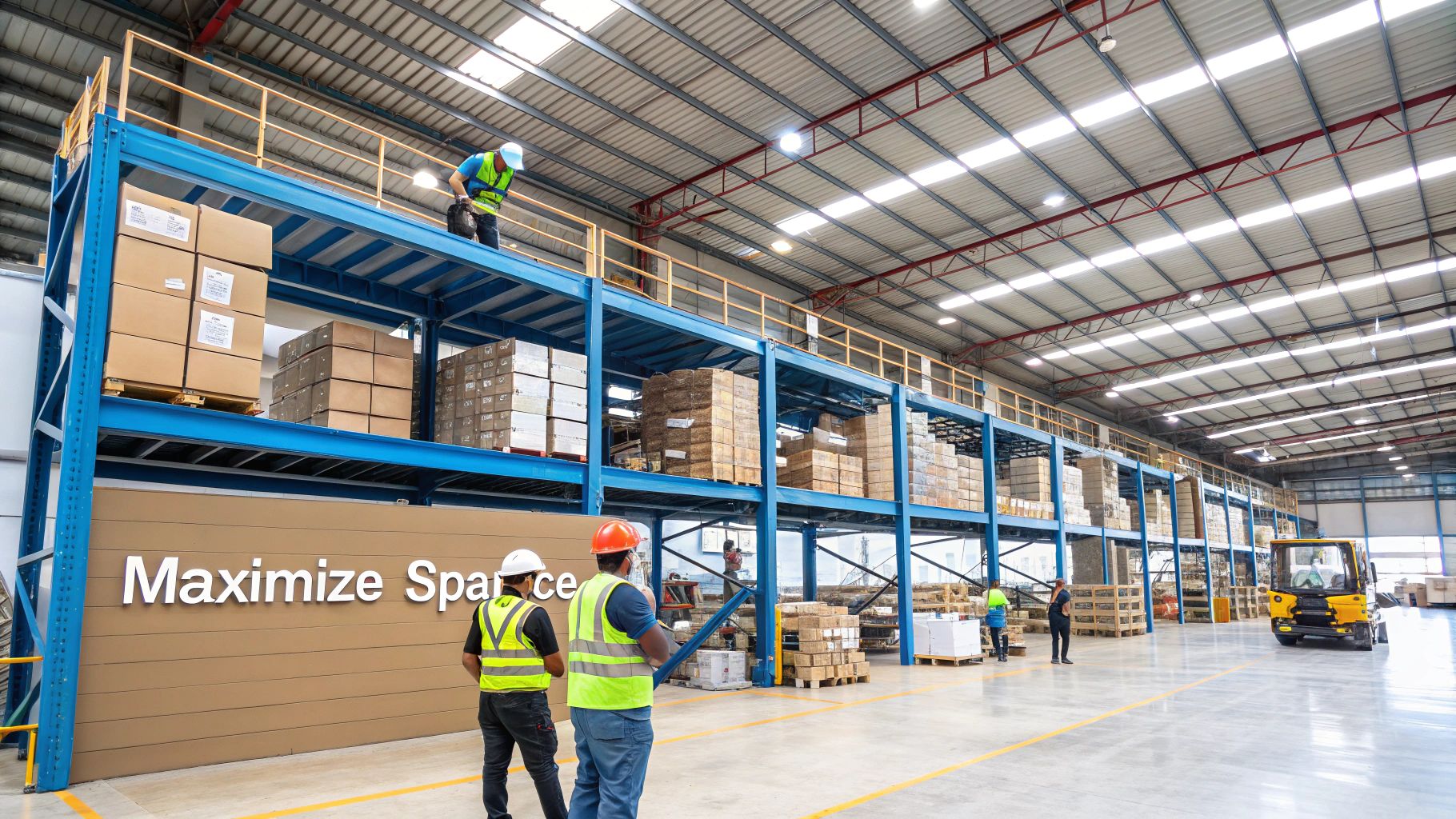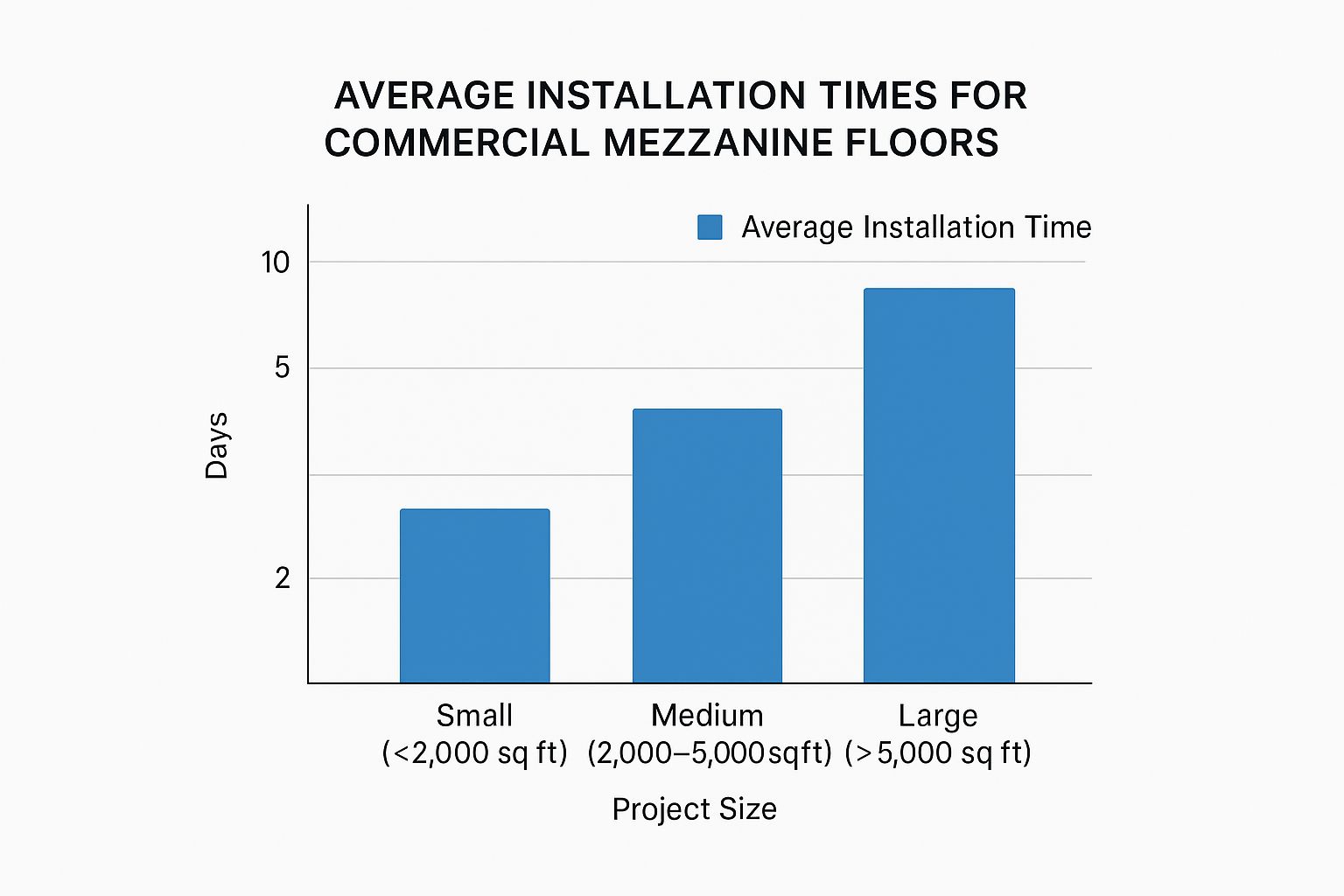When you’re staring up at the high ceilings in your facility, all that empty air can feel like a huge missed opportunity—a constant, nagging reminder of untapped potential. This is where commercial mezzanine floors come in. They are the go-to strategic solution for transforming that vertical void into valuable, productive floor space.
It’s best not to think of it as complex, disruptive construction. Instead, see it as unlocking a new, highly functional chapter for your building, but without the headache and expense of a full-blown relocation.
Unlock Your Hidden Vertical Space

For any UK business looking to expand its operational footprint, a commercial mezzanine floor is an incredibly powerful tool. It’s essentially an intermediate, semi-permanent level installed between the main floors of a building, creating brand-new space seemingly out of thin air. This isn't about adding a full, traditional second storey; it's a far more elegant and efficient approach.
Just imagine your warehouse, retail unit, or office. Now, picture a sturdy, custom-engineered platform sitting smartly above the existing floor. Suddenly, you have a brand-new area ready for whatever your business needs most, whether that's more storage, office space, or a production line. This clever use of vertical space is a genuine game-changer for businesses feeling the squeeze.
More Than Just an Extra Level
If you only see a mezzanine as an 'extra level,' you’re missing its true value. It’s a strategic asset that delivers tangible benefits with remarkable speed and efficiency. The proof is in the numbers, with the global mezzanine floor industry projected to hit USD 24.57 billion by 2030. This boom is fuelled by businesses just like yours demanding cost-effective, scalable solutions.
A mezzanine floor essentially doubles your usable floor area without expanding your building’s footprint. It’s a cost-effective expansion that enhances workflow and optimises your current lease.
Core Benefits for Your Business
The advantages of installing commercial mezzanine floors go far beyond simply getting more room. They represent a smart, strategic investment in your operational capacity. The core benefits really boil down to this:
- Cost-Efficiency: It is significantly more affordable than relocating to larger premises or undertaking a major building extension. Think of the savings on rent, rates, and hefty construction costs.
- Rapid Installation: Because the components are prefabricated off-site, the installation process is incredibly fast—often taking just a few weeks. This means minimal disruption to your daily operations.
- Ultimate Flexibility: These structures are typically demountable. If your business needs to move, the mezzanine can be dismantled and reinstalled at your new location, protecting your investment.
What’s more, these platforms are fully customisable. They can be designed to house additional offices, perhaps using partitions to create defined, quiet work areas. You can learn more about how to achieve this by checking out our guide on maximising space with partitioning systems.
By turning unused overhead space into a functional asset, a mezzanine tackles your immediate needs while future-proofing your facility for whatever comes next.
Understanding Your Mezzanine Design Options

A commercial mezzanine floor is so much more than just a platform of steel and wood; it's a bespoke solution, engineered to slot perfectly into your business's operational DNA. To get that perfect fit, you first need to get to grips with the fundamental design choices that will form its blueprint. These decisions are critical, as they directly shape its function, cost, and long-term value.
Thinking about the structure itself is always the best place to start. A mezzanine isn’t just dropped into your building; it's integrated in a very specific way. The two main approaches offer their own distinct advantages, depending entirely on your existing setup and what you hope to achieve.
Freestanding vs Integrated Structures
The most common approach you’ll see is the freestanding mezzanine. Think of it like a massive, incredibly strong table. It stands on its own legs, completely independent of your building’s walls or main framework. All the weight it carries is transferred directly down to the floor slab through its own set of steel columns.
This independence is its greatest asset. It gives you ultimate flexibility, allowing installation in almost any building with enough headroom. Better yet, if you ever decide to relocate, it can be dismantled and taken with you.
The alternative is an integrated or rack-supported mezzanine. With this setup, the mezzanine floor is built directly into a new or existing pallet racking system. The racking uprights cleverly pull double duty, supporting both the pallets of goods below and the new floor level above. It's an incredibly space-efficient solution for warehouses and distribution centres that need to combine high-density storage with extra floor space for tasks like picking, packing, or light assembly.
The choice between freestanding and rack-supported isn't just a technical one—it's strategic. Freestanding gives you the versatility for varied uses like offices or production areas, while rack-supported is the definitive space-saver for intensive storage operations.
Nailing this choice sets the stage for a truly optimised space. For businesses in the self-storage sector, there are even more specialised designs to think about. You can explore some of these by reading about innovative mezzanine floor designs to optimise your self-storage space in our detailed guide.
Defining Load Capacity and Decking
Once you’ve settled on the structural type, the next critical factor is load-bearing capacity. This simply means how much weight your new floor can safely hold, and it's measured in kilonewtons per square metre (kN/m²). This isn't a one-size-fits-all number; it has to be precisely matched to whatever you plan to use the floor for.
Here are a few typical load ratings to give you an idea:
- Light Office Use (approx. 3.5 kN/m²): Perfect for standard office furniture, computer gear, and everyday foot traffic.
- Standard Storage (approx. 4.8 kN/m²): This is the most common rating. It's designed for hand-loaded storage, light goods, and general picking areas.
- Heavy-Duty Storage (approx. 7.5 kN/m²): Engineered for areas where you'll be using pallet trucks or storing heavier, bulkier items.
- Heavy Machinery/Production (10+ kN/m²): This is a specialist capacity, built to support production equipment, heavy plant, or high-density racking systems.
Getting this wrong is simply not an option, as it’s a matter of safety and legal compliance. Any professional supplier will carry out a thorough assessment to make sure the structure is specified correctly for your needs.
Finally, the decking material is the surface you'll actually be walking and working on. The industry standard, and the most cost-effective choice, is 38mm particle board. It’s ideal for the vast majority of storage and office applications. For more demanding environments, you might consider other options:
- Steel Grating: This allows light and air to pass through, which is often a requirement of fire regulations in certain layouts.
- Composite Decking: A highly durable and moisture-resistant option that provides a more premium, hard-wearing finish.
Essential Safety and Access Features
A useful mezzanine is a safe mezzanine. Period. The design absolutely must include features that ensure your team can use the space securely and efficiently. Key elements here are custom-designed staircases for people to get up and down, and pallet gates for safely loading and unloading goods with a forklift.
Those gates are a non-negotiable safety feature. A simple swing gate or an up-and-over pallet gate creates a protected edge, preventing dangerous falls when moving stock between levels. When you combine this with robust handrailing and kick plates around all exposed edges, you ensure your new space is fully compliant and, most importantly, safe for your team.
Navigating UK Building Regulations and Compliance

Getting a commercial mezzanine floor installed successfully isn't just about clever design and solid construction. It's about making sure every single nut, bolt, and beam is fully compliant with UK law. While this part of the process can feel a bit intimidating, it’s a non-negotiable step that guarantees the safety and legality of your new space.
It helps to think of compliance not as a roadblock, but as a built-in quality control checklist for your investment. The two main hurdles you'll face are Building Regulations approval and, in some situations, planning permission. Getting your head around the difference between them is the first step to a smooth, stress-free project.
Planning Permission vs. Building Regulations
It’s a common mix-up, but these two serve entirely different functions. Planning permission is all about the bigger picture—how a development impacts the local community and environment. It looks at things like the building's external appearance and how it will be used.
Building Regulations, on the other hand, focus squarely on the health and safety of the people who will be using the building. They set out the technical standards for design and construction, covering everything from structural integrity and fire safety to accessibility. For virtually all commercial mezzanine floors, you absolutely must get Building Regulations approval.
The good news? Most mezzanine projects don't need full planning permission. Because they’re usually classed as demountable, internal structures, they often fall under ‘permitted development rights’. There is a critical exception, though: if the mezzanine is going to increase permanent retail floor space or change the building's exterior, you will almost certainly need planning permission.
The Non-Negotiables of Building Control
When you submit your project, a building control officer will review your plans against a strict set of criteria. Their one and only goal is to sign off on a structure that's fundamentally safe and fit for purpose. This means they’ll be putting several key areas of your mezzanine design under the microscope.
Three of the most critical aspects they will examine are:
- Structural Safety: The design has to prove the mezzanine can safely take the weight it's intended for. This involves complex calculations for the steelwork, columns, and foundations to ensure they can support people, equipment, or stock without any risk of failure.
- Fire Safety: This is absolutely paramount. Your structure might need to be fire-rated, typically for 60 minutes, to protect it from collapsing in a fire. This often means cladding columns in special protective materials and installing a fire-rated suspended ceiling underneath.
- Safe Access and Escape: The plans must show clear and safe ways for people to escape in an emergency. This includes the number, location, and design of staircases, making sure they’re adequate for the number of people who will be using the new level.
Navigating the fine print of compliance is a complex but vital job. A reputable supplier will manage the entire Building Regulations application for you, dealing with approved inspectors to ensure a seamless approval and a fully certified installation.
Staying Current with Regulatory Changes
Building codes aren't set in stone; they're regularly updated to reflect new safety standards and construction techniques. It is vital to stay informed about the latest updates, such as the Section 6 of Scottish Building Regulations, to ensure your mezzanine project meets all current compliance requirements.
This constant evolution means that a design that was perfectly compliant a few years ago might not pass muster today. Partnering with an expert who stays on top of these changes is your best insurance against costly rework or a failed inspection. For a deeper dive into the specifics, you can find a wealth of information by exploring our detailed guide to UK building regulations. Ultimately, ensuring your project meets every standard is the only way to protect your staff, your business, and your investment.
Calculating the Cost and Your Return on Investment
Let's talk numbers. When you're considering a significant upgrade like a commercial mezzanine floor, getting a firm grip on the finances is essential. It’s easy to look for a simple price per square metre, but the reality is that the total investment is shaped by a unique blend of factors specific to your project. Looking past a generic estimate is the key to seeing the true value and building a solid business case.
The final cost isn't just about size; it's about what you plan to do with the space. A light-duty office mezzanine has completely different structural demands from one designed to support heavy machinery or high-density pallet racking. Every one of these requirements influences the design, the materials, and ultimately, the price tag.
Key Variables That Shape Your Investment
Several core elements will directly influence your total project cost. Thinking through these factors with your supplier is what leads to a far more accurate and reliable quotation. Think of them as the building blocks of your investment.
The most significant variables include:
- Load Capacity: As we've touched on, what you'll use it for dictates the strength needed. A floor for light storage will naturally be more affordable than one engineered for heavy industrial applications that demand a higher kN/m² rating.
- Custom Features: Your specific operational needs will determine the extras. This covers the number and type of staircases, whether you need pallet gates for safe goods handling, and any specialised handrailing.
- Site Access and Complexity: The condition of your building really matters. An open, clear warehouse is much simpler to work in than a facility riddled with obstructions, tight access points, or an uneven floor slab that needs levelling work first.
- Fire Protection: Depending on its use and size, Building Regulations may require your mezzanine to be fire-rated, typically for 60 minutes. This involves adding fire-resistant cladding to columns and installing a suspended ceiling, which adds to the cost but is a critical, non-negotiable safety measure.
This is exactly why a generic online calculator can be so misleading. Here in the UK, commercial mezzanine floors have become a go-to solution for tackling space constraints, with construction typically priced between £75 and £150 per square metre. Where your project falls in that range depends entirely on the factors above.
Beyond the Upfront Cost: The Real ROI
The true financial power of a mezzanine isn't just in its installation cost but in its return on investment (ROI). This is where the numbers really start to work in your favour. The ROI comes from a combination of direct cost avoidance and massive operational gains.
The most compelling financial argument for a mezzanine floor is a direct comparison. Pit the one-time cost of the mezzanine against the endless, escalating expense of leasing additional commercial space. Over a few short years, the mezzanine pays for itself.
Imagine your business needs an extra 500 square metres of space. You have three paths: lease another unit, build an extension, or install a mezzanine. Leasing means you’re stuck with ongoing rent, business rates, and service charges that bleed cash year after year. A building extension is a huge, capital-intensive project, often bogged down by long timelines and major disruption.
A mezzanine, on the other hand, is a one-off capital expense. Once it's paid for, it generates value indefinitely. Just look at how quickly these projects come together.

As you can see, even large-scale mezzanine projects can be completed in a matter of weeks, not months. This minimises operational downtime and gets you to that return on investment much faster.
To give you a clearer picture, this table breaks down the potential costs of each option over a 5-year period.
Cost Comparison: Mezzanine Floor vs Traditional Expansion
This table illustrates the potential cost savings of installing a commercial mezzanine floor compared to leasing new space or constructing a building extension over a 5-year period.
| Expense Type | Commercial Mezzanine Floor (500 sq m) | Leasing New Warehouse Space (500 sq m) | Building Extension (500 sq m) |
|---|---|---|---|
| Initial Outlay | £50,000 (Avg. £100/sq m) | £12,000 (Deposit + Legal) | £600,000 (Avg. £1,200/sq m) |
| Annual Rent | £0 | £40,000 (Avg. £80/sq m) | £0 |
| Annual Business Rates | £0 (Often exempt) | £20,000 (Avg. 50% of rent) | £30,000 (Increased property value) |
| Annual Service Charge | £0 | £5,000 | £0 |
| Maintenance/Repairs | £500 (Minimal) | £2,500 (Variable) | £3,000 (New structure) |
| Total 5-Year Cost | £52,500 | £349,500 | £765,000 |
The numbers speak for themselves. While a mezzanine requires an initial investment, its long-term cost is drastically lower than the alternatives, freeing up capital that can be reinvested into growing your business.
How a Mezzanine Drives Tangible Value
Calculating the full ROI means looking at every financial benefit the new space provides. It’s a multi-faceted value proposition that directly strengthens your bottom line.
Here’s how a mezzanine actively boosts your finances:
- Increased Operational Capacity: More space means more capacity for stock, production, or people. This allows your business to take on more work and generate more revenue, all from the same premises.
- Improved Workflow Efficiency: By creating dedicated zones for different business functions—like storage, packing, and administration—you can streamline processes, cut down on wasted movement, and make your team more productive.
- Potential Business Rates Avoidance: In many cases, because a mezzanine is classified as a demountable structure, it does not increase the rateable value of your property. This can lead to substantial, ongoing tax savings compared to a permanent extension.
When you're budgeting, it's also helpful to have a broad sense of market prices. For more general budgeting, especially for the raw materials involved, a tool that predicts construction material costs can be invaluable. By combining these direct and indirect financial benefits, you can build a robust business case that demonstrates clear, measurable, and long-term value.
How UK Industries Use Mezzanine Floors
Theory is one thing, but seeing how mezzanines work in the real world is where the penny really drops. Across the UK, smart businesses are using these clever structures to solve nagging space problems, completely transforming their facilities from the inside out. It’s one thing to look at a technical drawing, but it’s another to see how other companies have already put them to work and reaped the rewards.
From huge warehouses to busy high-street shops, these examples show that a mezzanine is far more than just an extra floor. It's a strategic move that drives growth, boosts efficiency, and even improves the customer experience. Each story starts with a familiar business headache and finishes with a clear, positive outcome.
Case Study 1: The Warehouse That Doubled Its Stock
A third-party logistics (3PL) provider in the Midlands had a problem every growing business dreams of—and dreads. Their warehouse was at bursting point. With demand through the roof, they were actually turning away new contracts simply because they had nowhere to put the stock. Moving was out of the question financially, and all that empty air above their heads in the high-ceilinged unit felt like a massive wasted opportunity.
The answer was a freestanding, multi-tier mezzanine that created over 1,000 square metres of new space right inside their existing warehouse. The ground floor was kept clear for bulky pallet storage and processing incoming goods. Meanwhile, two brand-new levels above were kitted out with high-density shelving, perfect for smaller, fast-moving items.
The results were instant and impressive:
- Doubled Inventory Capacity: The business could suddenly hold twice the amount of stock, letting them take on new clients with confidence.
- Streamlined Picking Process: By separating bulk pallets from single-item picking, they slashed their pick times by an estimated 30%, getting orders out the door much faster.
- Avoided Relocation Costs: The entire project cost a fraction of what they would have spent on the expense and massive disruption of moving to a new, larger facility.
Case Study 2: The Retailer That Enhanced Customer Experience
A popular independent fashion retailer in Manchester was ready to expand its collection but was hemmed in by its single-floor layout. It’s in situations like this where the versatility of mezzanines really shines, especially in the demanding Commercial Retail industry. For this shop, the mission was to create a premium showroom for a new designer range without eating into their precious ground-floor retail space.
A sleek, lightweight mezzanine was installed at the back of the store. Designed with glass balustrades and a stylish open staircase, it immediately created an exclusive, boutique-like atmosphere. This new level became a dedicated space for personal styling sessions and showcasing high-end pieces, completely elevating the customer's shopping journey.
In the UK retail sector, where average customer conversion rates hover between 20% and 40%, creating a memorable in-store experience is everything. Mezzanines give retailers a fantastic tool to build engaging, multi-level environments that directly contribute to lifting this crucial performance metric. You can explore more about how mezzanines increase retail conversion rates to see the real financial impact.
The new showroom didn't just look good; it directly boosted sales and customer loyalty. It was proof that a well-designed mezzanine can be one of the most powerful sales tools you have.
Case Study 3: The Office That Fostered Innovation
An expanding London tech company was grappling with a classic open-plan office problem: it was noisy, distracting, and wasn't working for either focused tasks or team collaboration. They desperately needed different kinds of workspaces—quiet pods, breakout areas, and proper meeting rooms—but couldn't face the eye-watering cost and upheaval of moving to a new office in the city.
Their solution was to build a commercial mezzanine floor over part of their existing office. They designed this new upper level specifically for collaboration, filling it with comfortable seating, whiteboards, and informal meeting spots. The space created underneath the mezzanine was then converted into quiet, partitioned offices perfect for deep, focused work.
This smart division of space completely changed the company's culture and productivity. It gave employees the freedom to pick an environment that matched their task, nurturing both focused concentration and spontaneous teamwork. Not only did the project save them from an incredibly expensive relocation, but it also created a more dynamic and effective workplace that directly fuelled their innovative spirit.
Common Questions About Commercial Mezzanines
Even after seeing all the benefits, design options, and rules, you probably have a few practical questions buzzing around. That’s perfectly normal. Putting a commercial mezzanine floor in your facility is a big decision, and you need to be confident before moving forward.
To help clear things up, we’ve put together a few of the most common questions that business owners and facility managers ask us. Here are some straightforward answers to the things that often come up.
Do I Need Planning Permission for a Commercial Mezzanine Floor?
This is easily one of the most frequent questions we get, and the answer is usually good news. In the UK, you often don’t need planning permission for a mezzanine. Most are classed as demountable, internal structures, which means they typically fall under permitted development rights.
However, there are some important exceptions. You will almost certainly need planning permission if the new floor is going to be used for permanent retail sales space or if the project changes the outside of your building in any way.
The most important thing to remember is this: while planning permission might not be needed, Building Regulations approval is always mandatory. Every single mezzanine installation has to be reviewed and signed off to make sure it meets strict standards for structural integrity, fire safety, and access.
A good supplier will handle this entire process for you, working with the inspectors to make sure everything is fully compliant.
How Long Does a Mezzanine Floor Installation Take?
Business owners are often pleasantly surprised by how quickly a mezzanine project can come together. The on-site build is remarkably fast because most of the work—like fabricating the steel and other parts—is done off-site in a controlled factory setting.
Once the design is finalised and all the components are manufactured (which usually takes about four to six weeks), the actual on-site installation is often finished in just one to two weeks. Of course, the exact timeline will depend on how big and complex your project is.
To keep disruption to your business at a minimum, a professional installation team will work with you to create a schedule that fits your operations. This might mean scheduling the build over weekends, in the evenings, or in stages to keep your company running smoothly.
What Load Capacity Can a Mezzanine Floor Support?
There’s no such thing as a "standard" load capacity, because every mezzanine is custom-engineered for its specific job. This isn't a one-size-fits-all product. The structure's strength is calculated precisely based on how you plan to use the new space.
To give you an idea of what that means, here are a few typical load ratings:
- Light-Duty Office (3.5 kN/m²): Perfect for a standard office setup with desks, computers, and normal foot traffic.
- Medium-Duty Storage (4.8 kN/m²): This is a very common specification, ideal for hand-loaded shelving, packing areas, and general light goods storage.
- Heavy Industrial Use (10+ kN/m²): For the really demanding jobs, like supporting heavy machinery, production lines, or pallet racking, the structure can be engineered to handle much higher loads.
Your supplier will carry out a detailed assessment of what you need to design a structure that is perfectly and safely fit for purpose.
Can I Move or Extend a Mezzanine Floor Later?
Yes, and this flexibility is one of the biggest perks of a mezzanine. Most commercial mezzanine floors are designed as modular systems where the steel parts are bolted together, not welded to your building.
This clever design means the floor can be:
- Dismantled and Relocated: If your business moves, the mezzanine can be taken down, transported, and reassembled at your new site.
- Extended or Reconfigured: As your needs change, the mezzanine can be modified. You can easily add to its footprint or change the layout to suit new workflows.
This scalability makes a mezzanine a truly sustainable, long-term asset. It isn’t just a fix for today; it’s an investment that can grow and adapt with your business, protecting its value for years to come. For a closer look at the different types available, you can explore the options for commercial mezzanine floors and see how they can be tailored to specific industrial needs.
Ready to unlock the hidden potential in your facility? The team at Partitioning Services Limited has over 24 years of experience in designing, manufacturing, and installing high-quality, compliant commercial mezzanine floors across the UK and Europe. We manage the entire process, from initial concept to final sign-off, ensuring your project is delivered on time and on budget. Transform your space by visiting us at https://psllimited.co.uk to schedule your free consultation and site survey today.
Looking for help with your next project?
Whether you are new to self storage or already have an established self storage facility, we can provide you with guidance and a full quotation for any aspect of your works.

